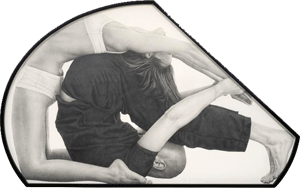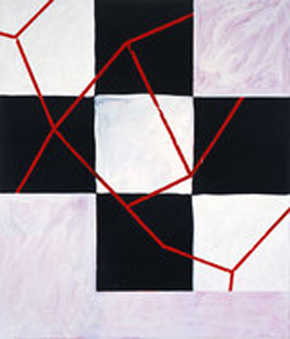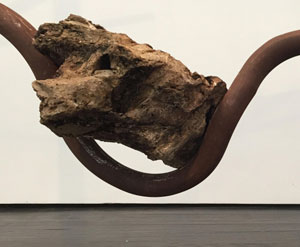Minimalism as Maze
John Haberin New York City
Gabriel Sierra and Karl Haendel
Jeff Williams and Ruby Sky Stiler
You could lose yourself in SculptureCenter. When Maya Lin repurposed the former trolley repair shop in Long Island City, she left the main floor largely undivided, bricks beaten and exposed. The basement, though, remains more of a challenge. Some tunnels run the length and some not, their scars still less hidden by Sheetrock—at least one barely wide enough for you. Who is to say which pipes or meters still have a function and which belong to a work of art?
With Gabriel Sierra, the challenge is that much more rewarding. Never mind that this maze runs entirely in straight lines, with signage to help. Karl Haendel, too, converts a room into Modernism as a maze. To keep you on your toes, it comes complete with dancers and monkeys.  If Minimalism seems by its nature impersonal and industrial, it bore criticism at the time for abandoning the art object in favor of theater. And sometimes theater was more than a metaphor for the gallery. Meanwhile Jeff Williams and Ruby Sky Stiler display gallery architecture as simultaneously debris and a graceful work of art.
If Minimalism seems by its nature impersonal and industrial, it bore criticism at the time for abandoning the art object in favor of theater. And sometimes theater was more than a metaphor for the gallery. Meanwhile Jeff Williams and Ruby Sky Stiler display gallery architecture as simultaneously debris and a graceful work of art.
(Eyes (wide) shut)
Gabriel Sierra has a habit of explaining things, leaving each piece untitled but then adding a subtitle as if he cannot help himself. Just one of nine works dispenses with Untitled but then leaves its title in parentheses anyway, like a secret just between us. The exception, (Door Open at 47%) is just that, onto a room that I had never so much as noticed before—and, by the look of things, neither had anyone else. Bricks, cinder blocks, and ceramic pipes look untouched by remodeling or use. Not that everything is so clear. Untitled (Badly Explained Rainbow) sounds like an apology, but then the small overhead projection, alternating between a slightly off-kilter green square out of Ellsworth Kelly and a straight black arrow, never quite works out to geometric abstraction, a rainbow, or signage.
Some things manage to be both literal and an enigma. A strip of wood, painted in diagonal stripes like a barrier at a construction site, serves as a warning, but of what? Another overhead projection amounts only to the number 9, because the work comes as number 9 on the handout serving as a map. Head down the old way, by crumbling stairs from the main gallery, and you may find nothing at all—neither signage nor art. At least you will until you come to the end of a tunnel, where Sierra, from Colombia, has added a second exit sign, at right angles to the first and unlit. Maybe you should just go back the way you came.
If you have been here before, you can lose yourself in another way, too, as in a familiar friend. A 2015 renovation, designed by Andrew Berman, added a front desk and an equally clean, blocky second stairwell next to an elevator. This artist, though, likes things the old way. One set of fiberboard panels coated in burlap nestles into the top of those stairs, as if accentuate its impersonality. And then another panel at the bottom of the stairs bars the way entirely. It somehow made sense that, when I visited, the elevator was down for repairs.
 The show is (o(op(ope(open)pen)en)n), to judge by its subtitle, and the parentheses trickle further into the words and the work. If they present a verbal maze, one last set of panels presents an actual one, as bare and simple as the rest. They come in pairs, like double doors. One in each pair rests at an angle to permit passage back and forth down the tunnel, and the open half alternates from left to right. It is all just part of the plan. Keep your eyes open, or maybe (open), and you will be fine.
The show is (o(op(ope(open)pen)en)n), to judge by its subtitle, and the parentheses trickle further into the words and the work. If they present a verbal maze, one last set of panels presents an actual one, as bare and simple as the rest. They come in pairs, like double doors. One in each pair rests at an angle to permit passage back and forth down the tunnel, and the open half alternates from left to right. It is all just part of the plan. Keep your eyes open, or maybe (open), and you will be fine.
An alternative can easily get lost amid the shimmer and gesture of all-over or pattern painting, ego and excess—but it may hold on to the clarity of late Modernism with little more than a sign. Mary Heilmann is back, with bowls and lawn furniture in cheerful colors. And then paintings adopt the motif of painted strips on a highway. Cyrilla Mozenter is back, too, as "The Failed Utopian." She does incorporate the word fail and the letter f. But then she picks up its hump and tail as a schematic animal in her abstract Eden, sometimes painted and sometimes sewn.
Back in Queens, the one improvement on Maya Lin is a drawing back. The renovation reduces the pebbled sculpture garden, which ran the length of the building and rarely held sculpture, to a tidy courtyard in back. Anthea Hamilton fills it with another tribute to blue-collar history—pipes painted and angled to look like filter cigarettes crushed in an ashtray. A fake-brick wall multiples the architecture. There she adds sculptured buttocks grasped by sculpted hands, to go with sculpted high boots, metal undershorts as the functional equivalent of chastity belts, and accessories to go with her video alternating a kabuki dancer, a female nude, and Venice. Maybe you have to share her temptations to appreciate them as libido or transgressions, or maybe you had better leave her to the signage and the architecture.
Monkeying with Minimalism
Remember the chimp that could do a plausible imitation of Abstract Expressionism? Me neither, but how about the primates who dabbled in Minimalism? If that sounds unlikely, they get plenty of help from Karl Haendel. Not that they look at home in their new studio. They pose atop geometric forms with shining fur and territorial stares, the kind that leave one uncertain whether they are confident or afraid. Viewers may feel the same.
Haendel is monkeying around with Minimalism from the get-go. The term evokes regularity and spareness, but the gallery runs disconcertingly riot. Remember (for real this time) the optical illusion of stacked cubes that might, at any given moment, face up or down? A checkerboard papers the floor at an angle to the entrance, as if tumbling into depth. More fields of black and white pick up from there, breaking up the walls in unpredictable ways. Some cubes come to life within the gallery, taking shape as sculpture on the floor.
The visual and physical obstacle course serves as a backdrop for Haendel's drawings. Some show humanity's closest relatives perched on something very much like the sculpture at hand. They might almost tempt one to climb up to face them down, but the sculpture, too, comes papered with images. They show objects that might use the cubes as pedestals, much like the monkeys. They veer between the familiar stuff of still life and more high-tech apparatus of uncertain purpose. Whatever the one nearest the entrance is measuring, someone's life may be at stake.
While the floor creates the illusion of depth, the objects look flattened under forcible pressure. A third set of images compresses space in a different way, up on the wall. Squeezed into gaps between the primates, they show couples pressing against one another, with the cool eroticism and agility of modern dance. Frames crop them tightly, adding their own felt pressure. Without them, they seem to say, the dancers could not hold those poses for long. And here, too, in their angled geometries, Haendel has caught depth coming and going.
In truth, a monkey as Jackson Pollock never made much sense, although plenty of derivative art these days could convince one otherwise. It takes discipline to make a drip painting, not to mention constant awareness of the painting's edge and of oneself. Minimalism may sound less demanding on our furry friends, but it demands just as much attention to constraints and to the room. Conceptual art may not ask much of the art object, but it does require a concept. Performance is often as self-indulgent as a child with a paintbrush, but Haendel's dancers know what monkeying around with art leaves out.
His installation touches on all these genres, in pursuit of the human. Titled "Organic Bedfellow, Feral Othello," it probably alludes to the board game more than to Shakespeare. Here Iago's "jealousy the green-eyed monster" must surrender to black and white. Still, Haendel suggests that one person's organic and natural is another person's feral and out of control. He also suggests that one person's art is another person's inhuman flailings. The monkeys never will understand, but then (to quote Shakespeare again) "misery acquaints a man with strange bedfellows."
Grace under pressure
Sculpture can exhibit something like no other art form, grace under pressure. All that mass means something, in physical terms, and Jeff Williams has a name for it. He calls his assemblages "Bending Moment." Not that all are warped or of the moment, but he can sure make them look that way, with obvious pleasure in his materials. A large, craggy fossil nestles into the dip in a rusted pipe. Another straddles parallel rods of rebar, as if holding them together or thrusting them apart.
The gallery explains bending moment as a term from physics—for that point at which materials give way, threatening to collapse an entire structure. Not exactly, I gather, but then even this former physics major had to learn a new concept. (In physics, moment is to rotation what force is to motion in a straight line, and bending moment, as I understand it, has a similar role in bending.) No matter, because the explanation captures that felt sense of pressure, mass, and motion. It also captures that moment at which unruly sculpture becomes unstable architecture. The work descends from above or rests on the floor, in unsteady relation to the walls and the room. 
The rocky and industrial materials have obvious affinities with Minimalism and earthworks. So does their balance between manufactured constraints and taking shape under their own weight, like a face-off between Mark di Suvero and Carl Andre. The works also recall trendier rock piles and trash heaps, whether the monumental for Ursula von Rydingsvard and Thomas Houseago or the "unmonumental" for Lee Ufan and Sarah Sze. Weight and binding play a central role for others as well, such as Shinique Smith, Judith Scott, and John Chamberlain. Yet Williams insists far more on materials with a role as structural supports, and then he makes them give way. Never mind that their impact on one another is largely an illusion.
They work best when the transformation seems to take place before one's eyes. Extruded rubber forms a bright yellow figure eight, with time for an additional loop along the way. A stalagmite hangs from a collapsed column of steel mesh, like a black mesh stocking losing its sex appeal. A steel clamp seizes rolled steel at its center, waist high, the pressure that much more evident from threaded rods extending from each end of the clamp. The belt tightening looks sure to give way at any moment to a deep breath. So much for grace under pressure.
Upstairs, Ruby Sky Stiler has her share of grace, too, as well as architecture. Black screens gather at the center of the room, in close encounters. They look like designer shelving or room dividers, but they quickly grow both more abstract and more human. Their curves in wood take shape as women out of traditional sculpture, although with a greater autonomy. It helps free them from the male gaze that even a seated figure could go eye to eye with the viewer, while the standing ones rise above. Still others are heads alone, like a fashionable update of Easter Island.
Stiler's close encounters with Modernism continue on the walls, in foam and resin. Black curves divide white surfaces into overlapping planes out of Cubism, most taking the leap from abstraction to portraiture. Again nothing really genders the curves but art history, and that is enough to give them an edge. Like the sculpture, the reliefs also exist firmly in three dimensions, even as Cubism insists on flatness. The black consists largely of cuts, exposing the underlying material as striated like metal. Then again, Analytic Cubism was soon to give way under pressure from reality to collage and construction.

Gabriel Sierra and Anthea Hamilton ran at SculptureCenter through January 4, 2016. Mary Heilmann ran at 303 through December 19, 2015, Cyrilla Mozenter at Lesley Heller through December 6, Karl Haendel at Mitchell-Innes & Nash through December 5, Jeff Williams at Jack Hanley through December 20, and Ruby Sky Stiler at Nicelle Beauchene through December 20.




